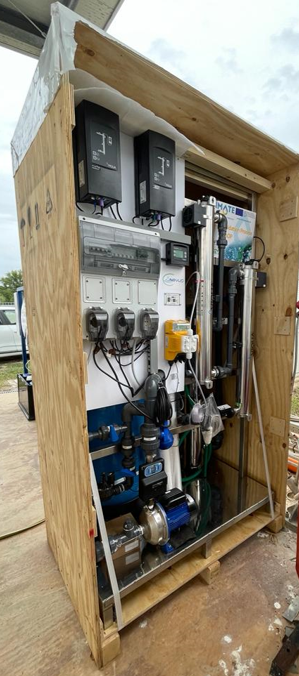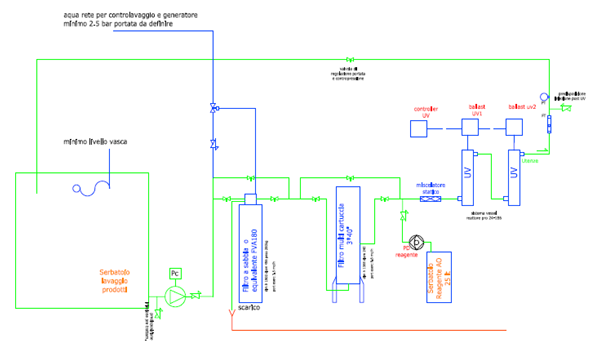
Unique selling points
- Monitoring system with online measure of fluorescence and UV absorbance
- Tests for monitoring emerging contaminants removal
Description of the technology
Advanced oxidation processes (AOPs) can be used to degrade trace constituents that cannot be removed completely by conventional wastewater treatments. AOPs are based on the in-situ generation of strong oxidants for the oxidation of organic compounds. This includes processes based on OH-radicals, which constitute the majority of available AOPs, but also processes based on other oxidizing species favouring sulfate or chlorine radicals. There are various different process technologies which have been investigated for use as AOPs. Several AOPs are already well established and operated at full-scale in drinking water treatment and water reuse facilities (Miklos et al., 2018). UV irradiation combined with radical promoters such as hydrogen peroxide (H2O2), chlorine (HOCl/OCl−) and peroxodisulfate (PDS,S2O8 2−) has been widely explored as UV-based advanced oxidation processes (AOPs) to remove organic contaminants (Miklos et al., 2019). Peracetic acid (PAA, CH3C(O)OOH) has gained intensive interest as a substitution for chlorine-based disinfectant due to several advantages such as limited formation of harmful disinfection byproducts (DBPs), low mutagenic or genotoxic effects on aquatic organisms, and no persistent residues in the environment (Zhang and Huang 2020). A useful approach to compare the oxidation potential of different AOPs in natural water/wastewater is the investigation of the reactivity of the produced/used oxidants with different Dissolved Organic Matter (DOM). Fluorescence is a fast and sensitive technique able to characterize bulk organic matter in natural and engineered aquatic systems. Fluorescence of natural water and wastewater tend to have distinct features with maxima located at characteristic combinations of excitation and emission wavelengths, and this spectroscopic technique has been shown to be very useful for discriminating between different source and components of DOM (Sgroi et al., 2020). Due to these facts, fluorescence has been also suggested as useful surrogate parameter to monitor emerging contaminant removal during wastewater treatment (Korshin et al., 2018).
In the H2020 ULTIMATE project an AOP pilot system (up to 5 m3/h) equipped with innovative sensors based on fluorescence/UV absorbance, has been developed to test the removal of emerging contaminants. The monitoring system based on fluorescence and UV absorbance sensors will be investigated to test its capability to monitor the performance of the wastewater treatment by AOP process.
Flow scheme of the technology

Synergetic effects and motivation for the implementation of the technology
- Removal of emerging contaminants
- Monitoring system
Pilot plant is equipped with innovative sensors based on fluorescence and UV absorbance that will provide real-time characteristics of organic content and possible relations with organic emerging contaminants removal.
Technology requirements and operating conditions
The pilot plant is equipped with sand and cartridge filter to reduce suspended solid concentration in the wastewater entering the AOP process. The presence of these materials, indeed, significantly affects the effluent optical properties, mainly the UV radiation transmission (Mierzwa et al., 2018).
Tab. 1 Typical ranges for operating parameters
|
Parameter |
Units |
Min |
Max |
Reference |
|
H2O2 dosage |
mg/l |
5 |
20 |
|
|
PAA dosage |
mg/l |
5 |
20 |
|
|
UV Fluence |
mJ/cm2 |
191 |
981 |
Key performance indicators
Tab. 2 Key performance indicators
|
Parameter |
Units |
Value |
References |
|
Reduction of UV absorbance and fluorescence intensity |
% |
50 - 90 |
|
|
Emerging contaminants removal |
% |
50 - 90 |
Case Study applying the technology
Publications
- David B. Miklos, Christian Remy, Martin Jekel, Karl G. Linden, Jorg E. Drewes, Uwe Hübner, Evaluation of advanced oxidation processes for water and wastewater treatment - A critical review, 2018
- D.B. Miklos, W.-L. Wang, K.G. Linden, J.E. Drewes, U. Hübner, Comparison of UV-AOPs (UV/H 2 O 2 , UV/PDS and UV/Chlorine) for TOrC removal from municipal wastewater effluent and optical surrogate model evaluation, 2019
- Gregory V. Korshin, Massimiliano Sgroi, Harsha Ratnaweera, Spectroscopic surrogates for real time monitoring of water quality in wastewater treatment and water reuse, 2018
- José C. Mierzwa, Raphael Rodriguez, Antonio C. S. C. Teixeira, Chapter 2 – UV-Hydrogen Peroxide Processes. Advanced Oxidation Processes for Waste Water Treatment, 2018
- Luigi Rizzo, Teresa Agovino, Samira Nahim-Granados, María Castro-Alférez, Pilar Fernández-Ibáñez, María Inmaculada Polo-López, Tertiary treatment of urban wastewater by solar and UV-C driven advanced oxidation with peracetic acid: Effect on contaminants of emerging concern and antibiotic resistance, 2019
- Sgroi, M., Gagliano, E., Vagliasindi, F.G.A., Roccaro, P., Absorbance and EEM fluorescence of wastewater: Effects of filters, storage conditions, and chlorination., 2020
- Sgroi, M., Snyder, S. A., Roccaro, P., Comparison of AOPs at pilot scale: Energy costs for micro-pollutants oxidation, disinfection by-products formation and pathogens inactivation, 2021
- Tianqi Zhang and Ching-Hua Huang, Modeling the Kinetics of UV/Peracetic Acid Advanced Oxidation Process

